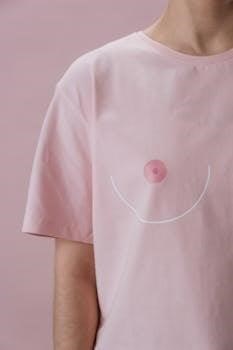Navigating the world of breastfeeding can be complex‚ and Medela nipple shields are a valuable tool. This comprehensive guide will help you understand the importance of correct sizing‚ ensuring comfort and effectiveness.
Medela nipple shields are thin‚ flexible silicone shields designed to help mothers breastfeed. They act as a barrier between the nipple and the baby’s mouth‚ offering solutions for various breastfeeding challenges. These shields can be beneficial for babies who have difficulty latching‚ mothers experiencing nipple pain or sensitivity‚ or those with flat or inverted nipples.
The Medela Contact Nipple Shield‚ available in various stores both online and in physical locations‚ is a popular choice. These shields are crafted to provide a comfortable and secure fit‚ aiding in a successful breastfeeding journey. Understanding their purpose and proper usage is key to maximizing their benefits‚ ensuring both mother and baby experience a positive feeding experience. Selecting the correct size is paramount for comfort and effectiveness.
This guide will delve into the specifics of sizing‚ helping you choose the right Medela nipple shield for your needs.
Importance of Correct Sizing
Selecting the correct size of Medela nipple shield plays a pivotal role in the breastfeeding experience. An improperly sized shield can lead to several issues‚ hindering both the mother’s comfort and the baby’s ability to feed effectively. If the shield is too small‚ it can cause discomfort and potentially irritate the nipple. Conversely‚ a shield that is too large may not adhere properly‚ leading to a poor latch and ineffective milk transfer.
Using the wrong size can also impact milk supply. Inefficient milk removal due to a poor latch can signal the body to produce less milk. A well-fitted shield‚ on the other hand‚ ensures a comfortable and effective breastfeeding session. It allows for proper suction and milk flow‚ promoting healthy milk production and a positive bonding experience between mother and child. Therefore‚ accurate sizing is crucial for a successful breastfeeding journey.

Understanding Medela Nipple Shield Sizes
Medela offers various nipple shield sizes to accommodate different nipple sizes. Knowing the available sizes is the first step towards ensuring a comfortable and effective breastfeeding experience.
Available Sizes⁚ Overview
Medela nipple shields are available in multiple sizes to cater to the diverse needs of breastfeeding mothers. Understanding the available sizes is crucial for selecting the right fit. Typically‚ Medela offers nipple shields in small (16mm)‚ medium (20mm)‚ and large (24mm). These sizes correspond to the diameter of the nipple.
It’s essential to measure your nipple correctly to ensure you choose the appropriate size‚ as the wrong size can lead to discomfort or reduced effectiveness. While 24mm is often considered the standard‚ it’s not a one-size-fits-all solution. The size you need depends on your unique anatomy.
Selecting the correct size plays a pivotal role in the breastfeeding experience‚ and Medela provides resources to help you determine the best fit. Using a sizing chart can be incredibly helpful in this process. Remember‚ comfort and proper latch are key indicators of a well-fitted nipple shield.
Standard Size (24mm)⁚ When to Use
The Medela nipple shield in the standard size‚ 24mm‚ is generally recommended for mothers with larger nipples. However‚ it’s crucial to understand that “standard” doesn’t imply universality. This size is best suited when your nipple diameter closely matches the shield’s inner diameter‚ ensuring comfortable and effective breastfeeding.
If you experience pain‚ discomfort‚ or difficulty latching while using the 24mm shield‚ it may not be the right fit for you. Proper sizing is paramount for optimal milk flow and preventing nipple damage. The 24mm size is designed to accommodate nipples that are larger in diameter‚ providing a comfortable and secure fit during feeding.
Always assess your individual needs and consult Medela’s sizing chart to confirm if the 24mm shield is appropriate for you. Remember‚ a well-fitted nipple shield should feel comfortable and allow your baby to latch effectively‚ promoting a positive breastfeeding experience.

How to Determine Your Nipple Shield Size
Finding the correct Medela nipple shield size is crucial for comfort and effectiveness. Utilize Medela’s official sizing chart and accurately measure your nipple diameter to ensure optimal fit.
Medela’s Official Sizing Chart
Medela provides a valuable resource to assist mothers in selecting the appropriate nipple shield size⁚ the official Medela sizing chart. This chart correlates nipple diameter measurements with the corresponding recommended nipple shield size‚ simplifying the selection process. The chart is designed to ensure comfort and efficient milk transfer during breastfeeding.
To effectively use the Medela sizing chart‚ it’s crucial to accurately measure your nipple diameter. This measurement will then guide you to the appropriate shield size‚ ensuring a proper fit and seal. Medela’s chart considers the variations in nipple sizes among women‚ acknowledging that a one-size-fits-all approach is ineffective.
By consulting the Medela sizing chart‚ mothers can avoid the discomfort and potential issues associated with using an incorrectly sized nipple shield. The chart is readily available online and often included with Medela nipple shield packaging‚ providing easy access to this essential information.
Measuring Your Nipple Diameter
Accurately measuring your nipple diameter is a crucial step in determining the correct Medela nipple shield size. This measurement ensures a comfortable and effective breastfeeding experience. The most common method involves using a ruler or measuring tool after a breastfeeding session‚ when the nipple is slightly more relaxed and extended.
To measure‚ gently compress the nipple and measure across the base‚ excluding the areola. It’s important to measure both nipples‚ as they may differ slightly in size. Record the larger measurement to ensure the nipple shield provides adequate coverage without causing discomfort or impeding milk flow.
Alternatively‚ some resources suggest using a nipple sizing tool‚ which often includes a set of templates with varying diameters. By comparing your nipple to these templates‚ you can determine the closest matching size. Remember that accurate measurement is key to selecting the right nipple shield size‚ promoting successful breastfeeding.

Where to Find Medela Nipple Shields
Medela nipple shields are readily available through various channels. You can find them at online retailers‚ offering convenience‚ or at physical stores‚ allowing for immediate purchase and consultation if needed.
Online Retailers
Numerous online retailers offer Medela nipple shields‚ providing a convenient way to purchase from the comfort of your home. Popular platforms like Amazon‚ Target‚ and Walmart often carry a wide selection of Medela products‚ including various sizes of nipple shields.
When shopping online‚ be sure to carefully review the product descriptions and customer reviews to ensure you are selecting the correct size and type of nipple shield for your needs. Many online retailers also offer helpful sizing charts and guides to assist you in making the right choice.
Furthermore‚ consider checking the retailer’s return policy in case the nipple shield doesn’t fit properly or meet your expectations. Some retailers may also offer expedited shipping options for urgent needs. Always ensure the website is a reputable source to avoid counterfeit products.
Comparing prices across different online retailers can also help you find the best deal. Take advantage of sales‚ discounts‚ and promotional offers to save money on your purchase. Online shopping provides a vast selection and convenience‚ making it a popular choice for many parents.
Physical Stores
For those who prefer an in-person shopping experience‚ Medela nipple shields are readily available at various physical stores. Major retailers like Target‚ Walmart‚ and buybuy Baby typically stock a range of Medela breastfeeding products‚ including nipple shields in different sizes.
Visiting a physical store allows you to examine the product packaging and‚ in some cases‚ consult with knowledgeable staff who can assist you in selecting the appropriate size and type of nipple shield. Some stores may also offer fitting services or provide access to lactation consultants for personalized guidance.
Pharmacies and drugstores‚ such as CVS and Walgreens‚ are also potential sources for Medela nipple shields. These stores often have a dedicated baby care section where you can find breastfeeding supplies and accessories.
Local baby boutiques and specialty stores are another option to consider. These stores often carry a curated selection of high-quality breastfeeding products and offer a more personalized shopping experience.
Checking the store’s return policy is advisable before making a purchase. Physical stores provide the advantage of immediate availability and the opportunity to physically inspect the product before buying.

Additional Tips for Nipple Shield Use
Beyond sizing‚ successful nipple shield use involves proper application and care. These additional tips will help ensure comfort‚ effectiveness‚ and a positive breastfeeding experience for both you and your baby.
Ensuring Proper Fit and Seal
Achieving a proper fit and seal is crucial for effective nipple shield use. Start by washing your hands thoroughly before handling the shield. Moisten the shield with water to help it adhere better to your breast. Position the shield with the nipple centered within the shield’s opening.
Gently press the shield onto your breast‚ ensuring that the entire areola is covered by the shield’s flange. The shield should create a secure seal‚ preventing air from entering between the shield and your skin. A good seal is essential for effective milk transfer and to prevent discomfort.
Observe your baby’s latch. They should latch onto the shield as they would your nipple‚ with a wide-open mouth. If the shield is too small or too large‚ it may be difficult for your baby to latch effectively. Experiment with different positions to find the most comfortable and effective latch for both you and your baby. If you experience any pain or discomfort‚ reassess the fit and seal of the shield.
When to Consult a Lactation Consultant
While this guide provides valuable information‚ there are instances where seeking professional guidance from a lactation consultant is highly recommended. If you’re experiencing persistent difficulties with latching‚ despite using the nipple shield‚ a consultant can assess your baby’s latch and offer personalized advice. Similarly‚ if you notice signs of reduced milk supply‚ such as infrequent feedings or inadequate weight gain in your baby‚ a consultant can help identify the underlying cause and provide strategies to increase milk production.
Pain during breastfeeding‚ even with the nipple shield‚ should not be ignored. A lactation consultant can evaluate your technique and the fit of the shield to identify and address any sources of discomfort. Additionally‚ if you’re unsure about the correct nipple shield size or are struggling to achieve a proper seal‚ a consultant can provide expert guidance and help you find the right fit.
Remember‚ lactation consultants are trained professionals who can offer invaluable support and solutions to breastfeeding challenges.